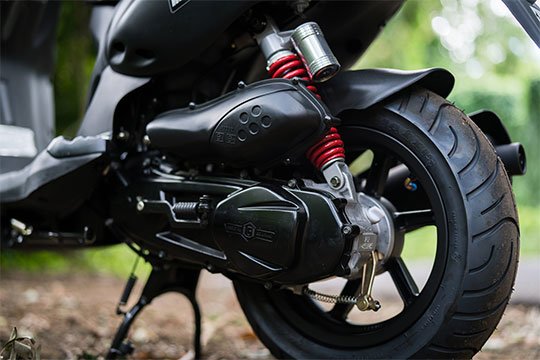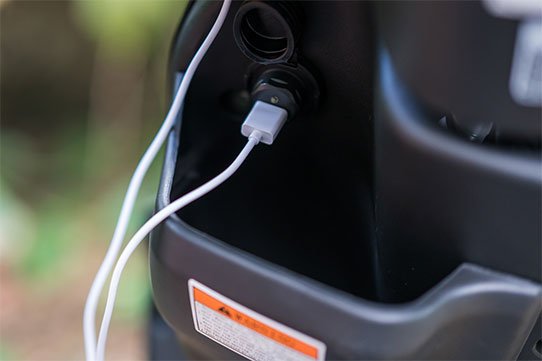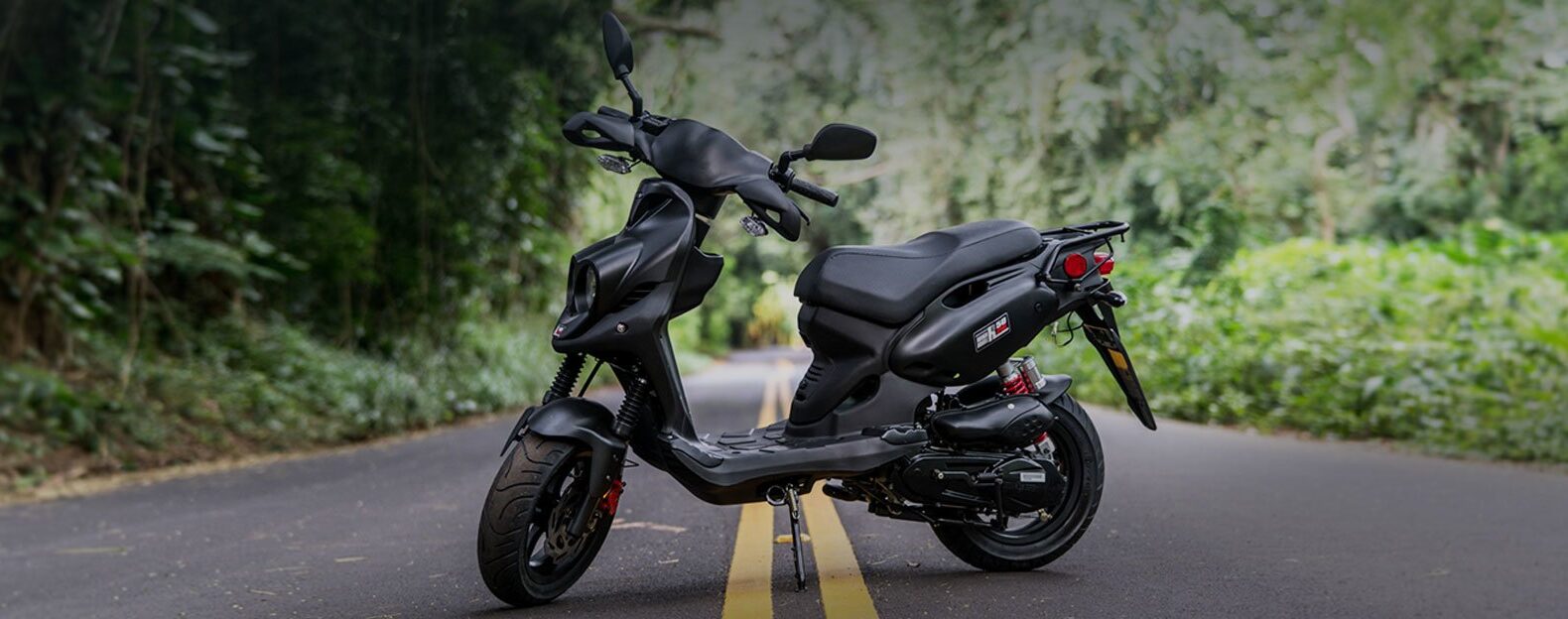Oh, sure; scooters are supposed to be utilitarian, simple, cheap transportation designed to get you and your stuff across town as cheaply and quickly as possible, as easy and convenient as a TV dinner. But scooterists also want style, usually European-flavored, please. How do you get both function and design and still keep a product reliable (and affordable)? I don’t know, but if you succeed, odds are the end result will be a Taiwanese-built scooter, a scooter like the Genuine Buddy 170i I got to ride around on, thanks to the generosity of Barry Gwin at S.F. Scooter Centre.

Genuine is an interesting company. Billing itself as “America’s Smallest Scooter Company,” it was started by Phil McCaleb in 1989. At first, McCaleb repaired and resold vintage steel-bodied Italian motor scooters in his hometown of Chicago, later moving into the parts business as Scooterworks USA. As scooters grew in popularity, McCaleb saw a business opportunity selling Indian-built Vespa replicas as the fashionable Stella. But McCaleb also saw the potential of selling rebranded high-quality twist-n-go automatic scoots – the Stella has an old-fashioned gearbox and clutch – to a growing market.
That resulted in the Buddy, a lineup of two- and four-stroke models based on the PGO PA series of retro-styled (but modern) machines. Never heard of PGO? Though founded in 1964, PGO may be best remembered for its joint technical venture with Piaggio Italy from 1972 to 1982. Since then, PGO has developed its own product line and expanded sales to 37 countries, including Europe and the USA. PGO’s were the first Taiwanese scooters exported to Europe (says PGO), bolstering its reputation for quality.

Genuine is a perfect match for a relatively small factory like PGO. Gwin says Genuine’s small size and knowledge of the U.S. market give it an advantage; “when you buy a Vespa or Yamaha scooter, it’s the same styling offered in Europe or Japan, but since Genuine is one of PGO’s biggest customers, they tailor models to our market, even pulling bikes off the assembly line” to make changes to color schemes. That flexibility and connection to customers give Genuine products a special feel in a market dominated by impersonal ‘world-market’ scooters.
Genuine knew it needed a freeway-legal scoot (150cc in most states). The problem, according to Gwin? Tighter emissions rules meant fuel injection, which tended to reduce power levels as they cleaned up exhaust effluvia. No problem – just up capacity a bit and give ’em a 170. Hence the Buddy 170i.
MotoUSA’s Bart Madson gave the Buddy Black Jack a thorough shakedown a few years back. He and other MotoUSA staffers liked it but found power lacking, reporting top speed in the mid-50s, making divided freeways no-zones for the little fella. Would the extra cubes spice things up? Barry said yes – one of his shop guys verified a 70-plus mph top speed via GPS on level ground.

Rolling it out of Barry’s shop and into a rare sunny San Francisco day, I knew this scooter wasn’t just about speed. The styling is killer, classy but not cheesy, with great color choices – my wife and I liked the Oxford Green with white stripe enough to think about getting one into our garage. Understated, distinctive, with a solid Italian vibe that doesn’t look forced.
The design and equipment could fool you into thinking PGO was still building Piaggio-designed scooters. The drive unit looks like a Vespa’s, as does the general layout of controls and instruments. There’s a fuel gauge but no trip odometer – too bad! But you get a nice storage bin inside the leg shield, complete with a 12-volt outlet for your cell phone. The seat pops open from the ignition lock, revealing the fuel filler and a storage bin that’s about big enough for a smaller full-face helmet. The tank holds 1.8 gallons.
Running gear is also reminiscent of Piaggio products. There’s a standard-issue fork up front with a 10-inch wheel (Vespas use 11-inch fronts) and a disc brake with a two-piston caliper. The rear wheel is a 10-incher as well, clad with a cheerful Maxxis 90/90-10 tire (same as the front) and slowed by a drum brake. Rear suspension is a colorful red-springed non-adjustable monoshock. A big oil cooler and spin-on oil filter are easily accessible (and perhaps crash or speed-bump vulnerable?) under the front of the bike. There is no kickstarter, unlike the smaller Buddies.
Getting on for the first time, I was surprised. Like a clown car, it’s roomier than it looks. Sure, riders over 5’8″ or so may be slightly cramped, but if you’re smaller it’s pretty comfortable, offering a relaxed and natural riding position. The seat is supportive but not too hard and the bars are well placed. The cool retro-styled round mirrors worked well, and I liked the feeling of riding such a tiny machine.
A tiny machine with a big motor. Twist the retro-chic brown right grip and the Buddy zips forward. I found fuel delivery spot-on, and the gear ratios and variator weights blend off-the-line pep, hill-climbing power and top end. The motor starts easily and warms up quickly, with no choke or wait time needed. I took the bike on the freeway, braving the grooved pavement of the Bay Bridge’s bottom deck and the salad-bowl sized potholes of I-580 through Oakland, and found the power adequate to keep up with law-abiding traffic. There’s probably a bit more on tap, but I didn’t want to stress a brand-new engine. Around town, you won’t feel a lack of power. You may have heard that San Francisco has steep hills – it’s true – but the Buddy 170i will squirt up any of them like a salmon leaping upstream.
You can even use your Buddy as a sportbike. That’s right – the Buddy can carve twisties. It steers so quickly you’ll think you’re crashing, what with its 10-inch wheels and skateboard-sized 48-inch wheelbase. But it’s still stable leaned over, and if you’re not auditioning for a career in MotoGP, you won’t drag the centerstand tang in left handers. The quick throttle response and good midrange pull will fire you down the straightaway to the next turn so you can brake and pitch it in again. It’s good fun.

The brakes are good, within reasonable expectations. They aren’t strong, and require a firm, four-finger squeeze front and back, but they are comparable to other scooter brakes and don’t fade. Totally adequate for around-town work.
That’s because the Buddy, despite the displacement boost, is still ideal for around-town conditions. But that’s where it shines. Light (claimed dry weight is 242 pounds) and easy to handle, it would be my ride of choice in a dense inner city. On the freeway the Buddy feels stable and isn’t overwhelmed by bumps and lumps, but it feels frantic, like it’s working harder than it wants to.
A benefit to sticking to surface streets is economy. Scanning Genuine numbers from website forum participants showed me that 85-95 mpg is routine. I saw ~80 on my test ride, but I spent those miles with the throttle wide open, so 90 seems attainable. That’s enough economy to feel twice as smug as a Prius driver, and ride past about 160 miles of gas stations. It’s economical to own – doing maintenance at a dealer will have you spending about $100 every few thousand miles.
At $3349, there are cheaper scooters in this class but plenty are more expensive, too, and don’t offer a two-year warranty (with roadside assistance – up to 100 miles free). Few are as much fun to ride or as tastefully styled. Genuine has a nice product lineup, and this Buddy 170i is a scoot I’d love to see in my garage.

